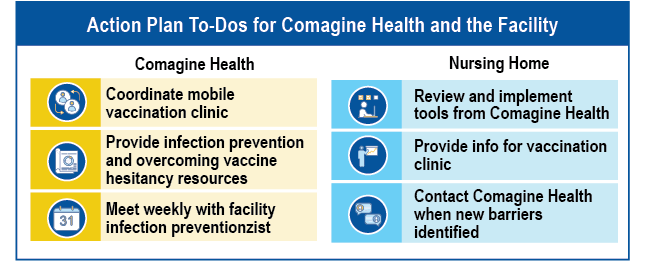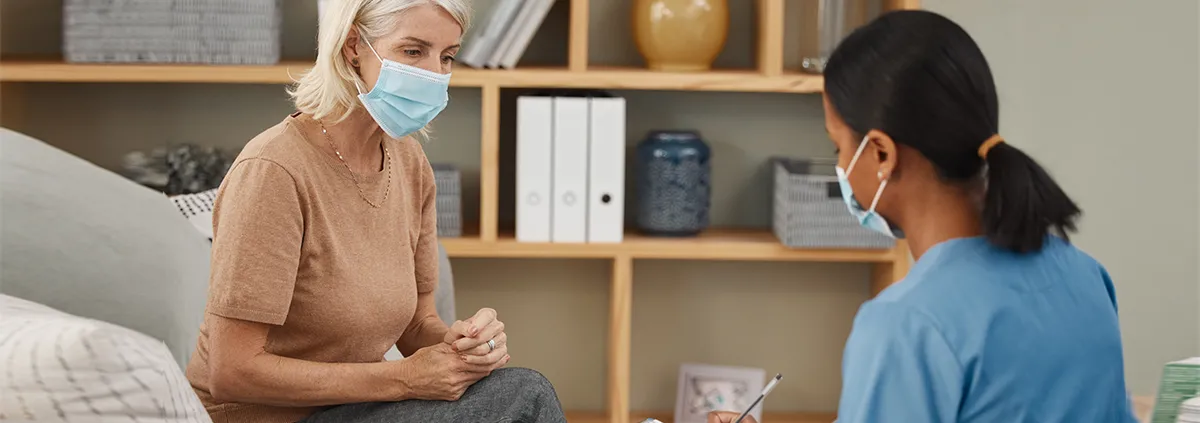A nursing home in a remote area of the Pacific Northwest was referred by the Centers for Medicare & Medicaid Services (CMS) to Comagine Health, a CMS Quality Innovation Network-Quality Improvement Organization (QIN-QIO), for assistance with improving its resident COVID-19 bivalent booster rate. With the help of Comagine Health’s one-on-one assistance and support that reduced staff burden, the facility saw a 36.13 percent net increase in its resident COVID-19 bivalent booster rate from the time the QIN-QIO made its initial outreach to the nursing home in January 2023 and the last report to the National Healthcare Safety Network (NHSN) in June 2023.
Using a Root-Cause Analysis to Identify the Cause of a Low Bivalent Booster Rate 
Comagine Health performed a root-cause analysis to determine the reason for the nursing home’s low resident COVID-19 bivalent booster rate. The analysis revealed the facility was, for months, without a consistent infection preventionist (IP). The facility’s vaccination and infection prevention programs were piece-meal, with no one person having full responsibility for either program. At the time the QIN-QIO reached out, a new IP had been hired but had not completed the Centers for Disease Control and Prevention (CDC) Nursing Home infection Preventionist Training Course. Achieving this certification was the IP’s priority, further hampering vaccination efforts.
Creating an Action Plan to Orient the New IP and Jumpstart the Facility’s Vaccination and Infection Prevention Programs
To help the facility achieve its goal of further developing its vaccination and infection prevention programs and training and certifying the new IP, Comagine Health developed an action plan to break down the process into manageable steps. The plan included:
Enrolling the IP in the CDC Nursing Home Infection Preventionist Training Course
Utilizing Comagine Health’s Resident COVID-19 Vaccination Tracker and Health Care Personnel COVID-19 Vaccination Tracker
Enrolling the IP in the state immunization registry
Enrolling the IP in Comagine Health’s Vaccination Station, a monthly interactive webinar session addressing questions and barriers to adult vaccination
Checking in with the state’s long-term care facilities coordinator for webinars, learning sessions and collaboration opportunities
Registering for Comagine Health’s NHSN Office Hours to have access to the QIN-QIO’s NHSN Subject Matter Expert
Reviewing Comagine Health’s Nursing Home Antimicrobial Stewardship Guide
The action plan also included three “to-dos” for both Comagine Health and the facility to complete. The purpose of these tasks was to help demonstrate the partnership between the QIN-QIO and the nursing home in this work. The tasks included:
For Comagine Health
Contacting the local health district to coordinate a mobile vaccination clinic
Providing resources to the DON and IP for infection prevention and overcoming vaccine hesitancy: 1) Tools for an Antibiotic Stewardship Program; 2) Checklist to Evaluate the Components of Your Antibiotic Stewardship Program; 3) Antibiotic Use Tracking Tool; 4) Motivational Interviewing Guide; 5) Quick Guide to Conversations that Promote Vaccine Confidence; 6) COVID Booster Essential for LTC Residents: A Postcard for Families
Meeting weekly for 30 minutes with the IP to discuss progress towards the facility’s goals and to address barriers
For the nursing home
Reviewing and implementing the tools and resources shared by Comagine Health
Providing necessary information for setting up the vaccination clinic
Contacting Comagine Health as soon as new barriers are identified
Arranging an On-site Clinic to Quickly Vaccinate Residents
As part of its to-dos in the facility’s action plan and to relieve some of the burden on the IP, Comagine Health reached out to the nursing home’s local health district which was hosting mobile vaccine clinics through its “Care A Van” program. The IP, who was new to the state and to the facility, had no idea how to tap into this resource and manage the logistics of calling and scheduling a visit. Competition for this service was also extremely high. Comagine Health leveraged its relationship with the health district and highlighted the vulnerability of the nursing home’s population and the need for a mobile vaccine clinic. Ultimately, the health district was able to prioritize the nursing home over other vaccination administration opportunities (i.e., at a shopping center) and make the Care a Van available. With the leg work done by the QIN-QIO, all the facility had to do was call Comagine Health’s contact at the health district and arrange a date for the Care a Van to visit.
Keys to Success
Comagine Health’s success can be replicated by taking the following steps:
Create action plans that include tasks for both the facility and the QIN-QIO to complete.
Identify and take advantage of opportunities to relieve burden for nursing home staff.
Offer easy-to-implement resources.
All nursing homes in the region served by Comagine Health that were referred to the QIN-QIO for assistance between October 16, 2022, and May 7, 2023, saw a 6.5 percent net increase in resident COVID-19 bivalent booster rates as compared to nursing homes in the region that were not referred to the QIN-QIO for assistance. In addition, the percentage of residents who are up to date in nursing homes in the region that were referred to the QIN-QIO for assistance increased by 19 percent, compared to residents who are up to date in nursing homes not referred to the QIN-QIO, which increased by only three percent.
Comagine Health’s Regional Nursing Home Resident COVID-19 Bivalent Booster Rates Including Referrals from October 16, 2022 – May 7, 2023
The graph compares bivalent vaccination rates of CMS-referred facilities (orange) with never-referred facilities (blue) and only includes referrals made between October 16, 2022, and May 7, 2023. Never-referred facilities did not meet initial criteria for booster referral because CMS focused on facilities with significantly lower rates.

This material was prepared by The Bizzell Group (Bizzell), the Data Validation and Administrative (DVA) contractor, under contract with the Centers for Medicare & Medicaid Services (CMS), an agency of the U.S. Department of Health and Human Services (HHS). Views expressed in this material do not necessarily reflect the official views or policy of CMS or HHS, and any reference to a specific product or entity herein does not constitute endorsement of that product or entity by CMS or HHS. 12SOW/Bizzell/DVA-1172-08/14/2023.

